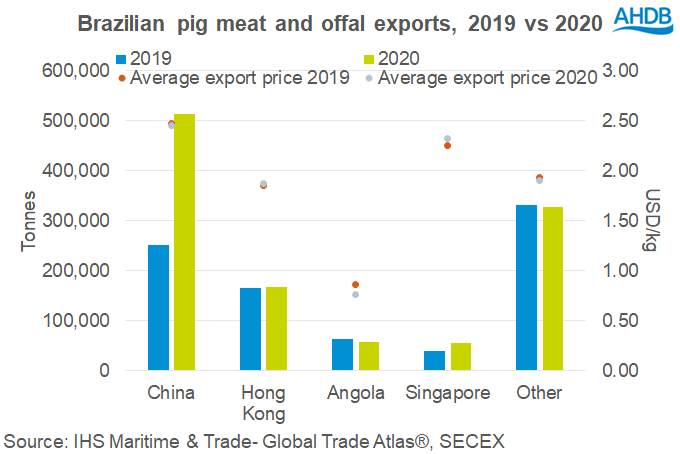China drives Brazilian export growth
Thursday, 11 February 2021
There was strong growth in the volume of pig meat exported from Brazil in 2020- up 32% on 2019 to 1.12 million tonnes. Exports to China were above 2019 throughout the year, with a particular peak in May, when volumes exceeded 53,000 tonnes (including offal). Demand from China was sustained due to the shortage of domestic pork while their herd is still recovering from African Swine Fever.

The Brazilian real weakened significantly against the US dollar in the middle of last year, attributed to the economic impact of the coronavirus pandemic. As such, while pork export prices have risen significantly in domestic currency, in US dollar terms, things have been more stable. This has helped enable large export volumes onto the global market. For 2020 overall, the value of Brazilian pig meat and offal exports was 81% up on the year, as prices rose by nearly 40%. In US dollar terms, value was 38% higher than in 2019, as prices were just 5% higher year-on-year.
Interestingly, this momentum does not seem to have been sustained into early 2021. There was a 5% drop in Brazilian pig meat exports during January, compared to year earlier levels. This was because shipments to Hong Kong were about half of the 2020 volume.
Overall, the USDA is still expecting growth in exports this year as increasing production outpaces recovering domestic demand. With Chinese demand expected to fall back, other markets may need to be explored, unless Brazil can capture more market share.
The shape of domestic demand will be dependent on Covid-19 developments in the country. Most Brazilian pork production is consumed domestically. If this market suffers, incentives to expand may be dampened, limiting supply, even if in the shorter-term exportable volumes are boosted. The weakness of the real will have also increased costs for imported products associated with pig production. Feed costs are also rising too, with strong export demand for feed ingredients, especially from China as producers there strive to rebuild the pig herd. Pig prices have risen to accommodate these changes, but unless there is robust demand on both the domestic and export markets, producers may find the market increasingly tricky.
Sign up for regular updates
Subscribe to receive pork market news straight to your inbox. Simply complete our online form.
While AHDB seeks to ensure that the information contained on this webpage is accurate at the time of publication, no warranty is given in respect of the information and data provided. You are responsible for how you use the information. To the maximum extent permitted by law, AHDB accepts no liability for loss, damage or injury howsoever caused or suffered (including that caused by negligence) directly or indirectly in relation to the information or data provided in this publication.
All intellectual property rights in the information and data on this webpage belong to or are licensed by AHDB. You are authorised to use such information for your internal business purposes only and you must not provide this information to any other third parties, including further publication of the information, or for commercial gain in any way whatsoever without the prior written permission of AHDB for each third party disclosure, publication or commercial arrangement. For more information, please see our Terms of Use and Privacy Notice or contact the Director of Corporate Affairs at info@ahdb.org.uk © Agriculture and Horticulture Development Board. All rights reserved.

